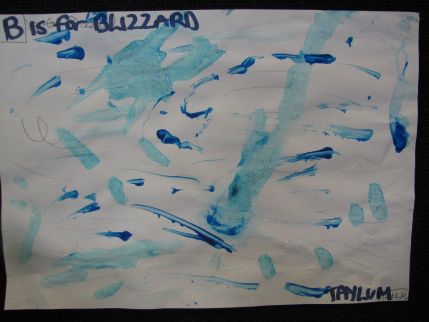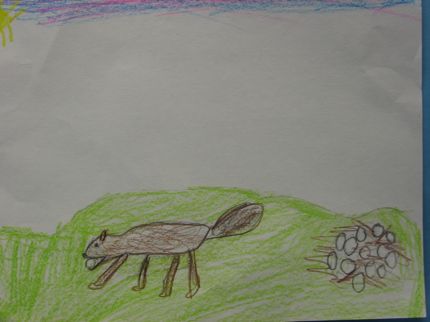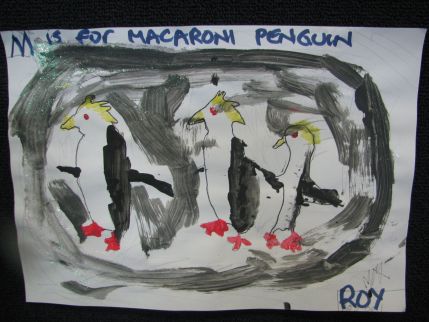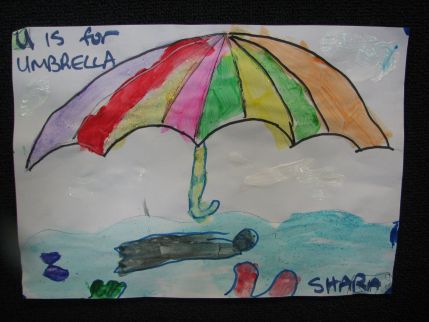Group 11
The I SEE ALPHABET Brrrrr Internet Book
By the Students of the North Pole Elementary School, Alaska USA and Queensland School for Travelling Show Children, Australia
Teachers: Betty Stroup (Alaska), Janet and Ragnar Purje(Australia)
November 2008
A is for the Arctic
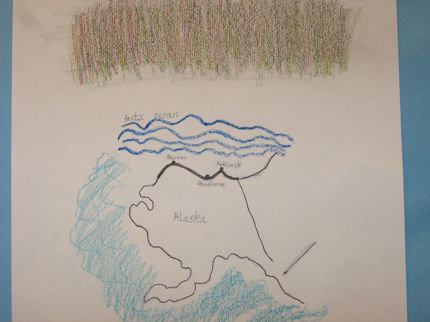 Because in Alaska, the Arctic Ocean freezes and beautiful Auroras or Northern Lights give spectacular shows of green and red colors.
Because in Alaska, the Arctic Ocean freezes and beautiful Auroras or Northern Lights give spectacular shows of green and red colors.
A is for Antarctica and Australia

and

Antarctica is a continent surrounded by oceans and is covered by ice. It lies south of the Antarctic Circle. The largest island continent in the world – often referred to as “the land down under”. The population of Australia is approximately 20 million. Canberra is the capital of Australia.
B is for Beluga

Because Beluga whales are cute, white and live in the coastal waters of the Arctic.
B is for Blizzard.
A cold storm with very high fast winds.
C is for Caribou
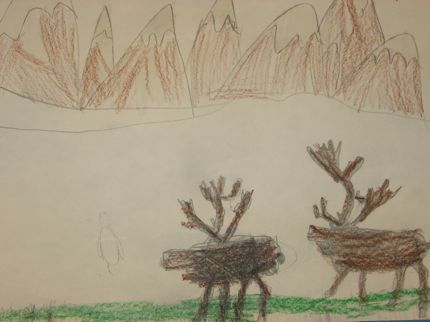
Because caribou travel to the Arctic to have their babies. It’s a long trip and they have to fight millions of mosquitoes by moving all the time or running into the Arctic Ocean.
C is for Crevasse.
A crevasse is a fracture in a glacier often covered by a snow-bridge and is nearly invisible. Some of these cracks are large enough to swallow tracked vehicles.
D is for the Arctic Ducks, geese, and swans.
Because in May ducks and birds migrate back to the Arctic to build nests and have their babies.
D is for Dive.
The seals and penguins dive into the water and, then they dive very deep below the surface to look for food.
E is for Ermine

Because ermine are small white furry animals in winter who eat lemmings but can be eaten by hawks or owls so “watch out!”
E is for Emperor Penguin.
The Emperor Penguin is the tallest and heaviest of all penguins and huddles to keep warm.
F is for the sly Arctic fox
Because foxes are clever and always looking for a quick meal. If they don’t catch something themselves they’ll eat another animal’s leftovers or steal an egg or two. How rude!
F is for Food Web.
The Antarctic food web is very sensitive to change. In Antarctica, light is the most important environmental factor affecting marine organisms. Without it, plants that are the base of all food webs, cannot grow. The most important plants in the Southern Ocean are tiny algae called phytoplankton. There are about 600 000 billion krill in the Southern Ocean weighing 500 million tonnes. They are the most abundant animal in the world.
G is for Glaciers
Because Alaska has lots of glaciers in mountains like the Brooks Range. Just standing by one turns the air cool. Burr!
G is for Glacier.
A glacier is a large body of ice moving slowly down a slope or valley or spreading outward on a land surface. The Byrd Glacier is a major glacier in Antarctica, about 136 km long and 24 km wide.
H is for Hibernation
Because the Arctic ground squirrel and a mother polar bear rest throughout the winter and survive off their stored up body fat. Polar bears give birth to two cubs in their winter den.
H is for Humpback Whale.
The humpback whale is a Baleen whale with long flippers and a raised, rounded back. It is able to swallow thousands of fish in one gulp and will eat 2000-2500 kg of plankton, krill and fish each day.
I is for Iceberg
Because the glacier ice that iceberg are made of is thousands of years old. It’s our planet’s fresh water faucet. In the ocean you only see the tip. Look out below!!!!!
I is for Iceberg.
The largest iceberg recorded is from, the Ross Ice Shelf and it measures 183 miles long (295 kilometres) and is about 25 miles wide (37 kilometres). It extends about 900 feet below the surface and rises about 120 feet (30 metres) above the ocean.
J is for Journey

Because caribou herds, songbirds, ducks, hawks and whales make very long journeys to return to the Arctic every year.
J is for James Cook.
Famous English explorer who is credited with discovering the east coast of Australia in 1770. One of Cook’s expeditions circumnavigated the globe at a very high southern latitude. He was one of the first to first to cross the Antarctic Circle on 17 January 1773.
K is for Krill
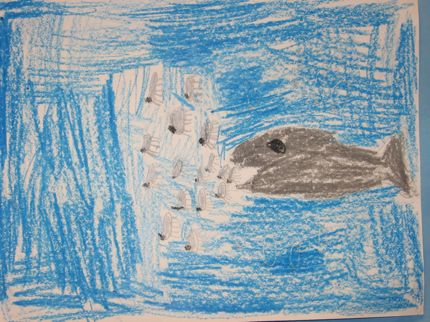
Because krill is an important part of the Arctic food chain. They are shrimp like crustaceans that are eaten by baleen whales, seals, squid and even some seabirds.
K is for Krill.
Krill are extremely small, pink coloured shrimp that feed on ice algae. Krill live in swarms. Some krill swarms can be up to 60km long. They feed on phytoplankton and zooplankton. The name krill comes from the Norwegian word krill meaning “young fry of fish.”
L is for Lemmings
Because lemmings look like furry hamsters that live in tunnels under the snow. They are white in winter and have lots of predators like the owl, Arctic fox and ermine.
L is for Leopard Seal.
The Leopard Seal is the second largest species of seal in the Antarctic (after the Southern Elephant Seal), and is near the top of the Antarctic food web.
M is for Mosquitoes
Because mosquitoes are a very important food source for Arctic birds. They hatch in the pools of water that cover the tundra in the summer.
M is for Macaroni Penguin and Mawson (Douglas).
and
Macaroni penguins eat plankton, squid and krill. It got its name because its feathers that arise from the top of its head look like macaroni. English explorers thought that it reminded them of the Yankee Doodle song: (“who stuck a feather in his hat and called it macaroni”). Douglas Mawson was a famous Australian explorer and geologist who was a member of the team which climbed Mount Erebus, Antarctica’s only active volcano, in March 1908.
N is for Narwhal
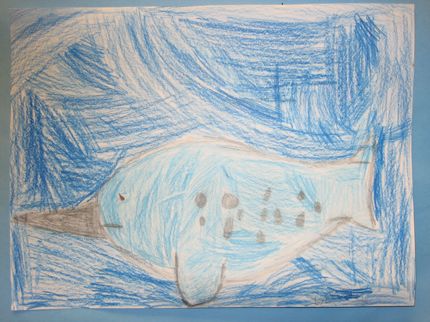
Because they live in the Arctic Ocean and have a long tooth on their upper jaw. How cool is that!!!
N is for Nature Reserve.
Natural Reserve area of significant importance. Antarctica is protected by the Antarctic Treaty. Just 2% of this continent is free of ice, allowing hardy animals and plants to survive.
O is for the Snowy Owl

Because they fly quietly in daylight hunting for lemmings, ptarmigan, hares, voles and ducks. Shhhhh!
O is for Ocean and Ozone.
The ‘ozone hole’ over Antarctica, lets in harmful ultra-violet rays to get through to the Earth which means there could be less phytoplankton in the Southern Ocean. No phytoplankton, no krill, no fish, no penguins, no seals and no whales and eventually no people!
P is for Permafrost, Polar Bears and Parka
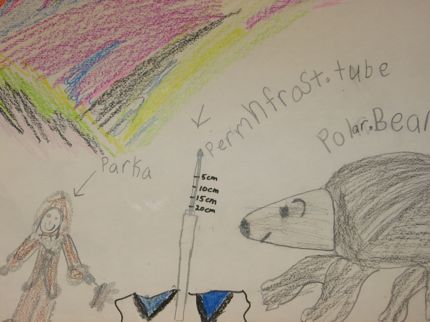
Because permafrost is frozen ground and I wear my parka in the winter. I stay away from polar bears!
P is for Pancake Ice and Phytoplankton.
and
Circular pieces of ice from 30 cm - 3 m in diameter, and up to 10 cm in thickness, with raised rims due to the pieces striking against one another. The pancakes can freeze together into larger floes or join to make a large ice cover. Phytoplankton floats beneath the Pancake Ice.
Q is for Quiviut

Because that’s the woolly fur under the muskox’s long outer hair that keeps it warm.
Q is for Quench.
The explorers used water to quench their thirst after the long trek across the ice.
R is for Raven

Because Alaskan ravens don’t migrate. They’re big with black feathers that help keep them warm by absorbing heat.
R is for Rookery.
A rookery is a colony of penguins.
S is for Seals

Because the walrus, ringed seal and sea lions all live in the Arctic. Their thick blubber keeps them warm and insulated from the cold.
S is for Sea Ice.
Ice that forms from frozen seawater. Sea ice covers large parts of polar waters in the winter and melts back each summer.
T is for Arctic Tern
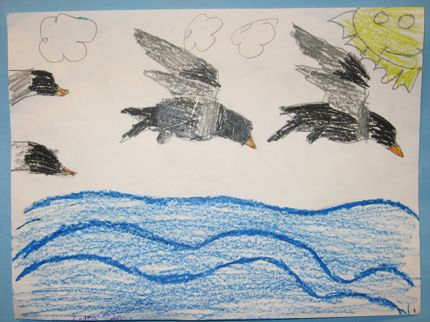
Because they are good fliers. They fly from South America to the Arctic over twenty thousand miles every year.
T is for Tasmanian Museum and Art Gallery.
The museum has Antarctic connections and Antarctic displays.
U is for Ulu (OO-loo)

Because the Inuit Eskimo use this special knife to prepare food by cutting and skinning fish or hide from the meat and bones.
U is for Umbrella.
The explorer used an umbrella to stop the gentle falling snow on his head.
V is for Vegetation

Because Arctic vegetation is hardy and blooms quickly during the summer. The animals and birds depend on it for food or for a place to build their nests.
V is for Vast.
The explorers began sailing across the vast sea to Antarctica.
W is for Arctic Wolf

Because wolves hunt in packs and need a lot of wilderness space to stalk their prey. The caribou and muskoxen can see them better on the open tundra.
W is for Weddell Seal.
A Weddell seal can grow to 9.5 feet (2.88 m) long and weighs between 880 to 1320 lbs (400 to 600 kg). It is named after Sir James Weddell, commander of British sealing expeditions in the Weddell Sea.
X marks the Spot (64°45′4″N, 147°21′7″W)

Because we live in the city of North Pole, Alaska which is about 170 miles from the Arctic Circle and 414 miles from the Arctic Ocean. It’s Santa Claus’ home too!
X is for X marks the spot.
The explorers placed an x on the ground to mark the spot of their discovery.
Y is for Yearling

Because young caribou under two years old are called yearling. When baby caribou are born they can walk after two hours. Keep up please and don’t speak to wolves!!!
Y is for Year book.
The Tasmanian Museum produced a year book with information about the Antarctic scientific journeys.
Z is for Zero
Because Arctic temperatures can drop below zero fast! Better wear warm clothes from head to toe!
Z is for Zoologist.
Zoologist studies and records scientific information about animals. Edward Wilson of the Antarctic was Zoologist to the British National Antarctic Expedition of 1901-1904. He is remembered today as the artistic scientist who died with Captain Scott.
Glossary and Other Arctic Words (Alaskan)
A- Arctic Ocean, Alaska, Aurora Borealis. Alaska (USA) is part of the northern circumpolar region along with Canada, Greenland, Norway, Sweden, Finland, Iceland and Russia that surrounds the Arctic Ocean. This combined landmass blocks warmer equator currents from mingling much as the lip on a saucer prevents coffee or tea from sloshing out of the dish. The result is the Arctic Ocean forms an ice pack that remains frozen most of the year. This year Alaska celebrates it’s 50th year of Statehood!
B- Belugas communicate with chirps, clicks, and whistles. Echolocation helps them locate the distance and size of objects as sound waves bounce off and return to the Beluga.
C- Caribou-Some Alaskan herds travel to calving areas in the Arctic National Wildlife Refuge beginning in late April. The Porcupine herd crosses the Brook Mt. range grazing on lichen, green plants, birch or willow twigs they dig up from under the snow. They give birth in May or early June.
D- Ducks-migrate to the Arctic because of the abundance of insects that hatch in the thousand of pockmarked pools of snowmelt. The Arctic is a perfect wilderness for hatching eggs and raising their young without the rest of the world interfering.
E-Eggs,Ermine-Ermines are also known as stoats. Their white coat hides them in the snow and allows them to sneak into snow tunnels to grab lemmings or voles. The tundra is full of eggs from thousand of waterfowls and birds. It’s a feast for any predator that sneaks in unnoticed.
F- Fox, Food Web-Food webs can be made up of several food chains. The fox eats the bird who eats the insects then the fox may be eaten by a polar bear. Parts of the fox will decompose and provide enrichment for the soil that feeds the seeds for the next plant that the lemming might need for food. And so it goes on and on.
G-Glaciers hold the world’s fresh water supply. Scientists study the accelerated rate of the break off and melting of glaciers to determine the affect it’s having on the climate of the world. One bit of data that’s being recorded is the change in the salinity of the oceans.
H-Hibernation-Arctic ground squirrels and the female polar bear will lower their breathing rate and body temperature to go into a sleep like state. Bears aren’t true hibernators because they have been known to wake up and roam, perhaps searching for food, before returning to their cozy dens to sleep again.
I- Iceberg, Inuit (Iñupiat) Eskimos, igloo- Iñupiat Eskimos live in modern homes not in igloos. Igloos can be built within a couple of hours by Iñupiat hunters to protect them from harsh and life-threatening situations while hunting.
J- Journey-Many of the Arctic animals travel from far off places often crossing mountains, boreal forests, tundra and forging rivers. Birds fly thousands of miles, without stopping or eating to reach the Arctic for the summer. After having their young and building up body fat, they make a return trip by instinct.
K- Kayak, Krill-small shrimp like creatures(crustaceans) that provide a major food source for marine life in all oceans. A kayak is a small, one or two manned boat made of seal skins and used by the Inuit People to hunt seals.
L- Laird Crashing, Collared Lemmings-Lemmings, an important Arctic food source, change the color of their fur from brown in summer to white in winter. They build tunnels in the snow and remain active in their burrows in winter producing lots of babies. Polar bears bounce on the ice pack to make holes for seals. They wait patiently for dinner. Sometimes the polar bear will cover its black nose with its huge white paw for added camouflage.
M- Mosquitoes, Midnight Sun-On June 22, summer solstice, the longest day of the year, there’s daylight even at midnight.The sun doesn’t set. Alaskans celebrate by watching baseball games, washing cars and running races. We spray ourselves with mosquito repellent for protections from those pesky insects.
N-Narwals have two teeth but usually only one on the upper jaw will grow between 6-10 feet long. This tusked tooth is found on male but scientist aren’t sure what it’s used for, maybe to fight for a mate.Fables have called them “unicorns of the sea”. People and Orcas are their primary predators.
O- Snowy Owls remain in the Arctic all year long and are completely covered by feathers from their beak to their toes. Only the male is white. The female has darker shadings and spots.They have excellent eyesight and can see a very long way off.
P- Permafrost, Polar Bears, Parka Pipeline, Polaris Star-Permafrost is frozen ground and above it is the North Star in the Ursa Minor constellation. During cold winter nights, Alaskans wear warm parkas or hooded jackets. The Pipeline is an engineering marvel, stretching and carrying oil over and under the tundra and frozen Arctic, crossing mountains and rivers for 800 miles from Prudhoe Bay in the North Slope to the ice free port of Valdez .
Q- Quivuit, Alaska Quarter—The softer inner hair keep oxen warm and when collected and woven, the quivuit makes incredibly soft and warm clothing. It would take a lot of newly minted, 50th anniversary Alaska Statehood quarters to purchase something made out of quivuit but it would be worth every cent!
R- Raven-This trickster, often considered a symbol of wisdom in Native stories and the bringer of Light into the Earth’s Darkness, is a “cousin” to the crow. They playfully fly around in pairs performing entertaining acrobatic rolls and playing tag. Large group of ravens are called a murder. Because they seem to eat anything ravens can be a nuisance raiding trash containers and spreading trash everywhere which is why they’ve been nicknamed “dumpster chickens” by many Alaskans.
S- Seals, Scientist, Snowfall-Both Polar Regions are considered deserts because of the small amounts of snow precipitation they receive. Much of what is already there has been compressed by millions of years of accumulation. Scientist are busy recording present warming trends happening everywhere but especially at the Poles.The changes in the Poles might be the “canary in the mine” to record rapid global warming trends.The torpedo shape of a seal’s body allows it to glide effortlessly under water resembling a ballerina’s precise dance movements. Beautiful to watch, they can stay under water up to 30 minutes before coming up for air. They will chew or bump up against the ice to create breathing holes. Polar bears and Iñupiat Eskimos look for these tell-tale holes when they hunt the seal.
T- Tundra means “treeless”. In the July and August, the tundra landscape holds pools of water from snow runoff and melt. The top 4-6 inches becomes swampy. The rest of the ground is permanently frozen all the time while Arctic temperatures don’t get higher than the high 50’s Fahrenheit.
U- Ulu and Umiak are used by Inuit Eskimos. The umiak is a large boat made from seals or walrus skin the Inuits hunt. These traditional tools and Ways of Knowing allow them to live their subsistence lifestyle in an unpredictable and harsh region. Modern conveniences and tools such as snow machines help them speed across the frozen tundra to hunt and visit other villages.
V- Vegetation (flora and fauna)-The hardy Arctic flowers almost bloom immediately and both flowers and plants such as lichen, grasses, berries are low to the ground for protection from strong Arctic winds. The fauna are the many animals that live in the Arctic and depend on the plants and flower as part of their delicate food chain.
W- Wolves, whales, winter solstice—The beluga, bowhead and narwhal whales are comfortable living in Arctic waters. Wolves are plentiful in Alaska and help to keep the caribou herd population down naturally.The winter solstice, Dec. 22, is the shortest day of the year. Beginning on Dec 23rd. the evening television news announcing how many minutes of daylight Alaska has gained each day. The promise of more daylight and thoughts of spring keep Alaskans going through the long dark and cold winter nights of January and February.
X- Marks OUR spot –Another name for the Arctic is the “Top of the World”. We love living in Alaska and in our home town of North Pole but it’s NOT the magnetic North Pole. We think our town is the best place to live because it’s decorated for Christmas all year long and of course, Santa lives here.
Y- Yearling –Yearlings are very young caribou, moose or even horses that are under two and still hang around mom.That’s cool!
Z- Zero, zooplankton-We are used to the cold up here and learn how to “layer up” to survive the frigid weather and wind. The wind can actually make it colder creating a “windchill” factor that is colder than the actual temperature outside. We also like to throw water into the air at -25 to -30 degrees Fahrenheit and watch it come down as crystallized ice particles. We go out for recess up to -20 F degrees below. Zooplankton—look at “zoo” in zooplankton to remember these are microscopic animals found in the oceans and an extremely important part of the marine food chain.
Antarctic Alphabet Glossary (Australian)
Algae – plants which grow in water or most ground, and which have no true stems, roots or leaves.
Antarctica – the fifth largest continent, c.5,500,000 sq mi (14,245,000 sq km), asymmetrically centered on the South Pole and almost entirely within the Antarctic Circle. It is the largest desert in the world with only thick ice layers replacing the typical sands and the most chilling place on Earth.
Antarctic Circle – the imaginary circle around the south of Earth.
Antarctic Treaty – recognised as one of the world’s most successful international agreements, 45 countries that have signed up to the Treaty which protects the area to be used for scientific research and peaceful purposes only.
Australia – the largest island continent in the world – often referred to as “the land down under”. The population of Australia is approximately 20 million. Canberra is the capital of Australia.
Baleen whale – whalebone is the means by which baleen whales feed. These whales do not have teeth, but instead have rows of baleen plates in the upper jaw - a flat, flexible plate that is used to strain food from seawater.
Blizzard – a cold storm with winds of at least 56 kilometres per hour (35 miles per hour) and temperatures below - 6.7°C (20°F). Usually also characterised by poor visibility due to snow blowing around. Little snow may actually fall during a blizzard, the high winds pick up snow from the ground and carry it around, and visibility is often greatly reduced.
Circumnavigated – to sail or fly completely around the world.
Colony – a group of the same type of animal.
Continent – one of the earth’s largest land masses.
Crevasse – a deep, usually vertical, crack or split in a glacier, occurs as a result of the brittle ice flowing over an uneven surface beneath the ice. Crevasses can easily become covered by blown snow, even very wide ones. Great care must be taken when crossing ice and snow fields to avoid them.
Discover – to be the first to find or find out about.
Discovery – a person, place, or thing that has been discovered.
Dive – to plunge into water; to power and plunge underwater.
Emperor Penguins – the Emperor Penguin is the tallest and heaviest of all living penguin species that only lives in Antarctica. The male and female are similar in plumage and size, reaching 122 cm (48 in) in height and weighing anywhere from 22–37 kg (48–82 lb). Like all penguins, it is flightless, with a streamlined body and wings stiffened and flattened into flippers for a marine lifestyle. Fish form the bulk of its diet, which can include crustaceans, such as krill, and cephalopods, such as squid. In hunting, the species can remain submerged up to 18 minutes, diving to a depth of 535 m (1,755 ft). The Emperor Penguin is perhaps best known for the sequence of journeys adults make each year in order to mate and to feed their offspring. The only penguin species that breeds during the Antarctic winter, it treks 50–120 km (31–75 miles) over the ice to breeding colonies which may include thousands of individuals. The female lays a single egg, which is incubated by the male while the female returns to the sea to forage; parents subsequently take turns foraging at sea and caring for their chick in the colony. The lifespan is typically 20 years in the wild, although observations suggest that some individuals may live to 50 years of age.
Expedition – an organized journey or voyage.
Explorer – a person who examines or investigates.
Explorers – one who travels, examines or investigates in a systematic fashion. Amundsen, Scot and Shackleton were Antarctic explorers.
Floes (ice) – a sheet of ice floating in the sea. East Antarctica has the largest ice floe.
Food web – a series of organisms in a community, each member of which feeds on another in the web and is in turn eaten.
Fracture – to break or crack.
Fry – a young fish.
Glacier – a large body of ice moving slowly down a slope or valley or spreading outward on a land surface.
Huddle – heaped or crowed together.
Humpback Whale – large rorqual whale (Megaptera novaeangliae) with long flippers and a raised rounded back.
Iceberg – a large piece of floating ice that has sheered, or broken off, a glacier or ice shelf. The visible part of an iceberg, above the water line, is only some 10 percent of the actual size of the iceberg. Icebergs occur in lakes and the ocean and can be vast; in some cases icebergs can be the size of islands or even small countries.
James Cook – famous English explorer who is credited with discovering the east coast of Australia in 1770. This discovery, by James Cook, eventually led to Australia being settled by the First Fleet, under Captain Arthur Phillips in 1778. James Cook was born in the Yorkshire village of Marton on October 27, 1728. The Antarctic continent was circumnavigated by Captain James Cook in the 18th Century, though he never actually saw it. James Cook was killed in Hawaii in 1779.
Krill – are extremely small, pink coloured shrimp that feed on ice algae. Krill live in swarms. Some krill swarms can be up to 60km long.
Latitude – an angular distance measured in degrees north or south of the equator.
Leopard Seal – the Leopard seal is the second largest species of seal in the Antarctic (after the Southern Elephant Seal), and is near the top of the Antarctic food chain. It is most common in the southern hemisphere along the coast of Antarctica and on most sub-Antarctic islands, but can also be found on the coasts of southern Australia, Tasmania, South Africa, New Zealand, Lord Howe Island, Tierra del Fuego, the Cook Islands, and the Atlantic coast of South America.
Macaroni Penguin – this large, crested penguin is similar in appearance to other members of the genus Eudyptes; the macaroni penguin is, however, larger than all other species except the royal penguin. Males and females are similar in appearance, but males tend to be slightly larger. The macaroni penguin is mainly active during the day. They feed mainly on krill (shrimp-like crustaceans), although in some areas, fish become an increasingly important food source as the breeding season progresses. It has been estimated that macaroni penguins alone consume four million tonnes of krill each year.
Mawson (Douglas) – (1882-1958). Australian explorer and geologist, born in Bradford, England, and educated at the University of Sydney. He was a member of the scientific staff in the 1907 expedition of the British explorer Sir Ernest Henry Shackleton, which came within 179 km (111 mi) of the South Pole. Mawson organised and commanded (1911-14) an Australasian expedition to explore Antarctic lands south of Australia; two of his companions perished during this arduous, extensive journey.
Mount Erebus – a volcano on Ross Island first visited in March 1908 by members of Shackleton’s expedition.
Museum – a building where objects of historical, artistic, or scientific interest are exhibited and preserved.
Nature Reserve – a nature reserve (natural reserve, nature preserve, natural preserve) is a protected area of importance for wildlife, flora, fauna or features of geological or other special interest, which is reserved and managed for
conservation and to provide special opportunities for study or research. Nature reserves may be designated by governments or by the United Nations.
Norwegian – a person from Norway.
Ocean – the vast body of salt water that covers almost three fourths of the earth’s surface.
Organisms – an animal or plant (living).
Ozone hole – a thinning of the stratosphere clouds.
Plankton – Plankton is defined as being those organisms that inhabit the upper regions of a body of water, but cannot move about against the influence of water movements such as currents, they move generally with the water column although may be able to move small distances.
Phytoplankton – microscopic free-swimming or suspended marine or freshwater plants within the plankton. Phytoplankton includes diatoms and other photosynthetic algae, a crucial part of almost all aquatic food webs.
Quench – to slake, satisfy, or allay (thirst, etc.). The explorers used water to quench their thirst after the long trek across the ice.
Rookery – a colony of rooks, the term is also used for a colony of penguins.
Scientific – used in science.
Ross Ice Shelf – is the largest ice shelf of Antarctica.
Sea ice – a general term for any ice that forms from frozen seawater. Sea ice covers large parts of polar waters in the winter and melts back each summer.
Slope – a slant or incline.
Snow-bridge – is an arc across a crevasse.
South Pole – South magnetic pole - the point on Earth’s surface that a south-seeking compass needle seeks. At the South magnetic pole a compass needle will point vertically downwards. This point is currently off the coast of Wilkes Land and wanders around.
Survive – to live, continue in existence.
Tasmanian Museum – Tasmania’s state museum and art gallery established in the 1840s as the museum of the Royal Society of Tasmania. The buildings and site are of historical significance and include the first purpose built museum building dated 1863, the Commissariat Store 1808, the Cottage c1810 converted 1828, the Bond Store and Court Yard and Gateway 1823, the Queen’s warehouse 1874, Art Gallery 1901, Custom House 1901 and extension of 1966 and 1986. The collections include Natural Sciences (Zoology, Botany, and Geology), Applied Science, Humanities (Art, Decorative Arts, Costume, Social History, Indigenous Cultures, Numismatics, Photographs, Documents and Ephemera) and Library. The Tasmanian Museum and Art Gallery also includes the Tasmanian Herbarium.
Ultra-violet – harmful end of spectrum light.
Valley – a long area of low land between hills, usually containing a river.
Vast – of very great area or extent; immense: the vast reaches of outer space; the Sahara and Antarctica are vast deserts.
Weddell Seal – the Weddell Seal (Leptonychotes weddellii), is a true seal that occurs in large numbers and inhabit the circumpolar region of the southern hemisphere, including Antarctica. A Weddell seal can grow 9.5 feet (2.88 m) long and weigh between 880 to 1320 lbs (400 to 600 kg).It is estimated that there are approximately 800,000 individuals today. It can regularly be seen in the many seasonally ice-free islands along the Antarctic Peninsula. This pinniped is not thought to migrate, and any local movements are usually the result of changes in ice conditions. It is named after Sir James Weddell, commander of British sealing expeditions in the Weddell Sea. It is the only species in the genus Leptonychotes.
Zoologist – a zoologist studies and records scientific information about animals. Edward Wilson of the Antarctic was Zoologist to the British National Antarctic Expedition of 1901-1904. He is remembered today as the artistic scientist Captain Scott.
Zooplankton – microscopic free-swimming or suspended marine or freshwater animals within the plankton. Many marine animals spend part of their lives as zooplankton, often as a juvenile life stage. One of the most important components of the Antarctic zooplankton is krill.
References
http://archive.amol.org.au/foundmade/instquery.asp?ID=T052&fm=y
http://dictionary.reference.com/browse/endemic%20
http://en.wikipedia.org/wiki/Arctic
http://encyclopedia.farlex.com/Dophins
http://encyclopedia2.thefreedictionary.com/Anarctica
http://geography.about.com/cs/politicalgeog/a/antarctica.htm
http://www.adb.online.anu.edu.au/biogs/A100444b.htm
http://www.allwords.com/word-krill.html
http://www.coolantarctica.com/Antarctica%20fact%20file/antarctica_glossary_of_terms2.
http://www.merriam-webster.com/dictionary/glacier
http://www.south-pole.com/p0000071.htm
http://www.thefreedictionary.com/Antarctic+Circle
http://www.yourdictionary.com/humpback
www.woodlands.co.uk/blog/practical-guides/the-woodlandscouk-jargon-buster-pt-2
Botanical Society of America.Inc
Collins Australian Pocket Dictionary.
Contributors to the Arctic Alphabet Book: Mrs. Betty Stroup, 2nd. Graders, North Pole Elementary School, North Pole, Alaska
A-Kecrya Sam
B-Cladie Eslick
C-Jonathan Paulson
D-Katie White
E-Michael Evans
F-Halee Howe
G-Brandon Wilson
H-Henry Lilley
I- H.Tyler Paek
J-Morgan Chiarell
K-Isabell Still
L-Ashuanna Hardy
M-Logan Lewellyn
N-Aidin Ash
O-Jonathan Paulson
P-Monique Bender
Q-Paige Rumfelt
R-Skylar Poehls
S-Ryland Nierman
T-India Smartt
U-Abgail Bystedt
V-Austin Schulte
W-Billy LaFon
X-Kecrya Sam
Y-Bradley Hallum
Z-Katherine Spencer
